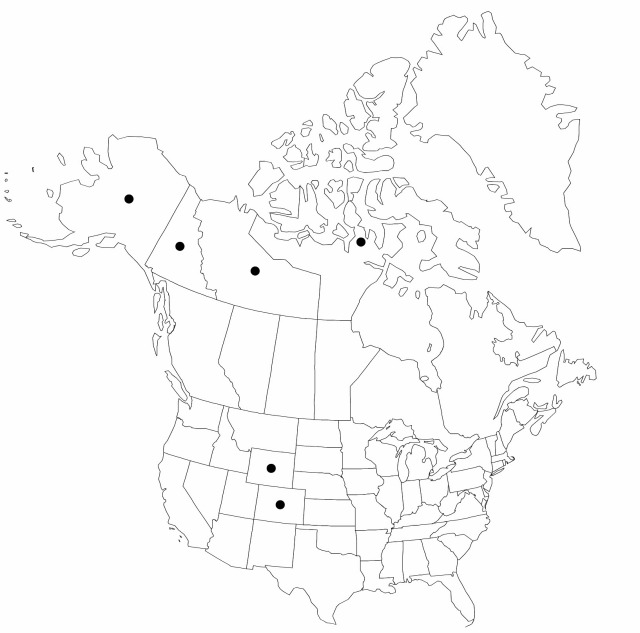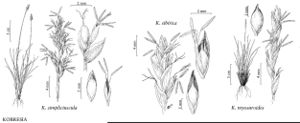Difference between revisions of "Kobresia sibirica"
Linnaea 39: 7. 1875.
FNA>Volume Importer |
FNA>Volume Importer |
||
| Line 14: | Line 14: | ||
|name=Kobresia hyperborea | |name=Kobresia hyperborea | ||
|authority=A. E. Porsild | |authority=A. E. Porsild | ||
| − | }}{{Treatment/ID/Synonym | + | }} {{Treatment/ID/Synonym |
|name=Kobresia macrocarpa | |name=Kobresia macrocarpa | ||
|authority=Clokey ex Mackenzie | |authority=Clokey ex Mackenzie | ||
| Line 32: | Line 32: | ||
|elevation=0–3600 m | |elevation=0–3600 m | ||
|distribution=N.W.T.;Nunavut;Yukon;Alaska;Colo.;Wyo.;c;n Asia. | |distribution=N.W.T.;Nunavut;Yukon;Alaska;Colo.;Wyo.;c;n Asia. | ||
| − | |discussion=<p>Kobresia sibirica, a local and variable species, is not yet fully understood. Some authors consider K. hyperborea and K. macrocarpa to be distinct endemic North American species; other authors include those and K. sibirica in the southwest Asian species K. schoenoides (C. A. Meyer) Steudel. In the Asian plants, the androgynous spikelets are reported as having 3 staminate flowers and no sterile scales.</p> | + | |discussion=<p><i>Kobresia sibirica</i>, a local and variable species, is not yet fully understood. Some authors consider K. hyperborea and K. macrocarpa to be distinct endemic North American species; other authors include those and <i>K. sibirica</i> in the southwest Asian species K. schoenoides (C. A. Meyer) Steudel. In the Asian plants, the androgynous spikelets are reported as having 3 staminate flowers and no sterile scales.</p> |
|tables= | |tables= | ||
|references= | |references= | ||
| Line 56: | Line 56: | ||
|publication year=1875 | |publication year=1875 | ||
|special status= | |special status= | ||
| − | |source xml=https://jpend@bitbucket.org/aafc-mbb/fna-data-curation.git/src/ | + | |source xml=https://jpend@bitbucket.org/aafc-mbb/fna-data-curation.git/src/8f726806613d60c220dc4493de13607dd3150896/coarse_grained_fna_xml/V23/V23_456.xml |
|genus=Kobresia | |genus=Kobresia | ||
|species=Kobresia sibirica | |species=Kobresia sibirica | ||
Revision as of 16:08, 18 September 2019
Culms 5–40 cm. Leaves: basal sheaths somewhat glossy, bladeless; blades filiform, 2–15 cm × 0.25–0.5 mm. Inflorescences simple, 10–20 × 4–8 mm; proximal spikelets usually androgynous with 1–2 staminate flowers, 1 pistillate flower, and 1–3 scales; distal spikelets staminate, 1-flowered. Scales brown, obovate-circular, 3.5–5.5 mm, midvein distinct only near base, margins hyaline, apex obtuse. Anthers 2–3 mm. Perigynia brown, finely veined, 3.5–5.5 mm, margins connate near base. Achenes 2.6–4 mm.
Phenology: Fruiting summer.
Habitat: Dry to mesic tundra
Elevation: 0–3600 m
Distribution

N.W.T., Nunavut, Yukon, Alaska, Colo., Wyo., c, n Asia.
Discussion
Kobresia sibirica, a local and variable species, is not yet fully understood. Some authors consider K. hyperborea and K. macrocarpa to be distinct endemic North American species; other authors include those and K. sibirica in the southwest Asian species K. schoenoides (C. A. Meyer) Steudel. In the Asian plants, the androgynous spikelets are reported as having 3 staminate flowers and no sterile scales.
Selected References
None.
